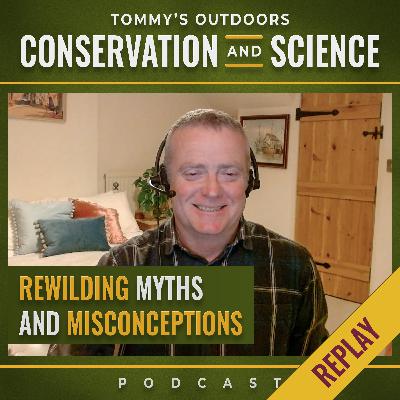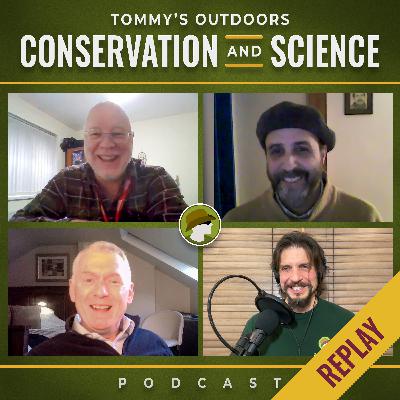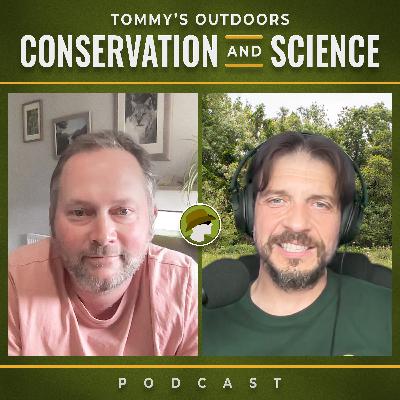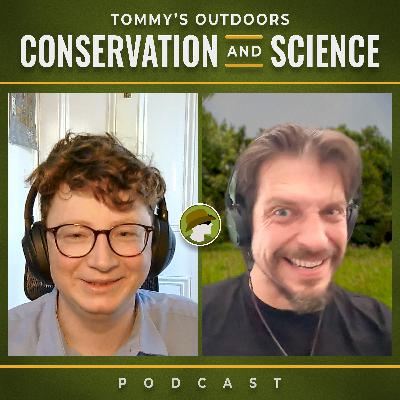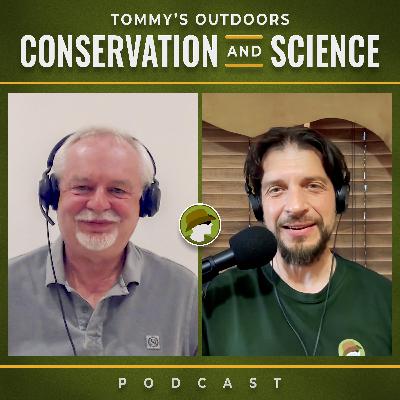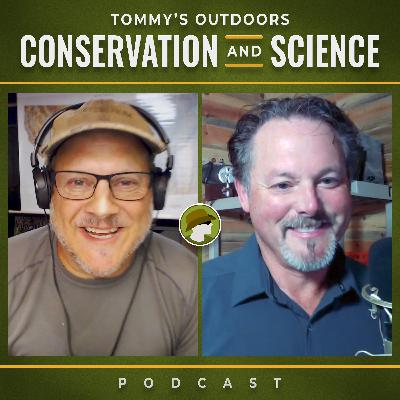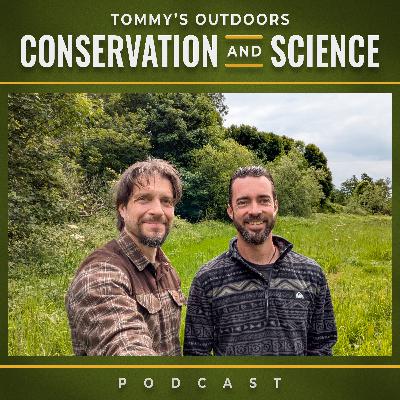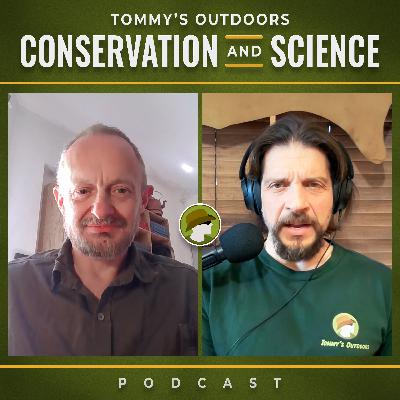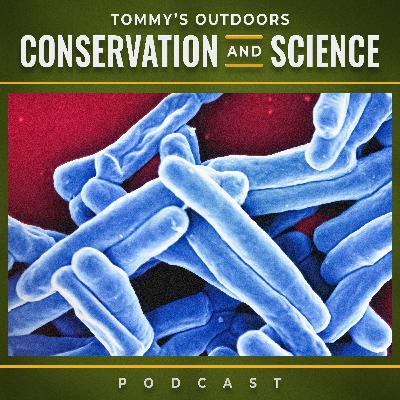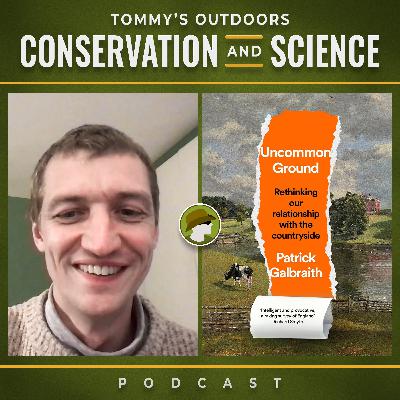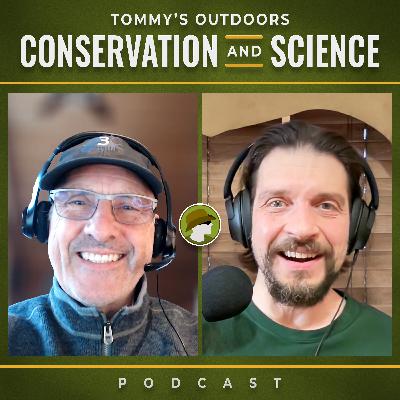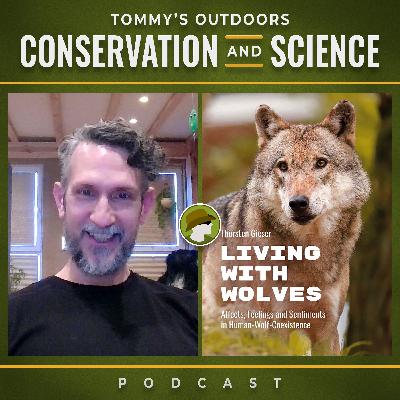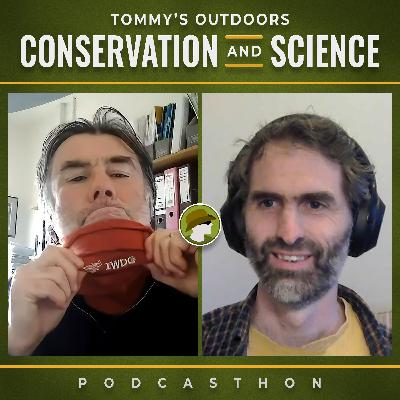Discover Conservation and Science
Conservation and Science

Conservation and Science
Author: Tommy's Outdoors
Subscribed: 69Played: 1,649Subscribe
Share
© Copyright 2024 Tommy Serafinski
Description
Are you tired of one-sided narratives about nature and conservation? Simplified takes that ignore the nuance and complexity of matters? This show brings you diverse perspectives on environmental stories, examining their ecological, social and political dimensions. Listen and become a well-rounded voice, empowered to foster dialogue and create change.
I'm Tommy Serafinski and this is the Conservation and Science podcast, where we take a deep dive into topics of ecology, conservation and human-wildlife interactions (which, in most cases, means human-wildlife conflict). I talk with world-class scientists, members of environmental organisations, practical conservationists, farmers, nature writers, and last but not least, hunters and anglers. My conversations cover biodiversity, conservation, hunting and fishing, rewilding and more.
Start with the acclaimed episode 163, “The EU Review of Wolf Protection Status.” It’s the perfect introduction to what this podcast has to offer.
I'm Tommy Serafinski and this is the Conservation and Science podcast, where we take a deep dive into topics of ecology, conservation and human-wildlife interactions (which, in most cases, means human-wildlife conflict). I talk with world-class scientists, members of environmental organisations, practical conservationists, farmers, nature writers, and last but not least, hunters and anglers. My conversations cover biodiversity, conservation, hunting and fishing, rewilding and more.
Start with the acclaimed episode 163, “The EU Review of Wolf Protection Status.” It’s the perfect introduction to what this podcast has to offer.
231 Episodes
Reverse
Is rewilding truly mainstream now, or does it remain mired in misunderstanding? Can we finally agree on what the term actually means? And is it really an anti-rural movement that seeks to empty the countryside of people? These questions have dominated conservation debates for years, and our conversation today tackles them head-on with refreshing clarity. Our guest is Dr Steve Carver, Director of the Wildland Research Institute at the School of Geography, University of Leeds, and Professor of Rewilding and Wilderness Science.In our conversation we explore how rewilding differs fundamentally from traditional conservation and regenerative farming. We examine the crucial role of scale, the problematic nature of fences in rewilding projects, and why the Oostvaardersplassen experiment in the Netherlands offers important lessons. Steve introduces his concept of 'nature-led versus human-led' approaches and explains why giving nature the space and time to determine its own trajectory remains the core principle. We also discuss the controversial question of whether projects like Knepp Estate truly qualify as rewilding or represent something else entirely.Throughout our discussion, Steve emphasises that rewilding is deeply context-specific and requires genuine local community engagement to succeed. He unpacks the relationship between wilderness and rewilding, explores why species reintroductions aren't mandatory, and shares his measured optimism about lynx returning to the UK (though wolves remain a more distant prospect). We also examine how the European interpretation of rewilding has evolved differently from its North American origins, and what this means for future conservation efforts. This episode offers a balanced, scientifically grounded perspective on where rewilding stands today and where it might be heading.Further reading:Guiding principles for rewildingSubscribe to Tommy's Outdoors: Conservation and Science NewsletterSupport the Podcast and Buy Me a Coffee.Recommended Books: tommysoutdoors.com/booksMerch: tommysoutdoors.com/shopFollow Tommy's Outdoors on Bluesky, Twitter, Instagram, YouTube and FacebookMentioned in this episode:This is the Conservation and Science podcast Replay series, a curated collection of best episodes from last year. If you are new to the show, this is an excellent opportunity to catch up with the most popular episodes from the back catalogue. And if you’re a regular listener, maybe you missed one of those or want to listen to one of them again. Don’t worry! The new episodes are being published on the regular fortnightly schedule, so keep tuning in for the new content every other Tuesday.
Can communities in Ireland and Britain learn to share landscapes with apex predators again after centuries of their absence? What does coexistence actually look like when people, livestock, and large carnivores occupy the same territory? How might wisdom from Himalayan communities inform debates about lynx reintroduction closer to home?Our conversation takes us from the remote mountains of Nepal to potential lynx habitats in Scotland and Ireland. Jonny Hanson travelled to the Annapurna Conservation Area to document how local communities live alongside snow leopards, creating a short film ‘Snow Leopard Trail’ that inverts the traditional conservation narrative. Rather than Western experts advising the Global South, Jonny learns from Nepali colleagues who have never experienced the extinction of experience that defines our relationship with large carnivores. His Nepali colleagues, award-winning conservation biologist Rinzin Lama and pioneering snow leopard tourism guide Tashi R. Ghale are the true guardians of these landscapes, managing coexistence in a region where 100,000 people and 100,000 tourists share space with one of the world's most elusive predators.The film and our discussion challenge romanticised notions of conservation whilst grappling with practical realities. We explore the tensions inherent in protected area management, the limitations of wildlife tourism as an economic solution, the importance of long-term funding for coexistence, and the need to bridge scientific rigour with the full spectrum of human experience, including spiritual and cultural values. The film premieres at festivals across Ireland and the UK in late 2025, offering a rare glimpse into what genuine coexistence requires.Where to watch:Queen's Film Theatre screening: ESRC Festival of Social Science in NI 2025Selected for Clones Film FestivalSubscribe to Tommy's Outdoors: Conservation and Science NewsletterSupport the Podcast and Buy Me a Coffee.Recommended Books: tommysoutdoors.com/booksMerch: tommysoutdoors.com/shopFollow Tommy's Outdoors on Bluesky, Twitter, Instagram, YouTube and Facebook
What exactly is rewilding? Does it simply mean bringing back wolves, lynx and bears, or is there more to it? Can we balance food production and rural community needs with land left to natural processes and wildlife conservation? To answer these questions, I talk with Ian Parsons, editor of "Great Misconceptions: Rewilding Myths and Misunderstandings", a new book that explores common assumptions and misconceptions about rewilding.In our discussion, we address aspects of rewilding that are often misunderstood or misinterpreted, sometimes innocently and at other times deliberately or even maliciously. We explore three topics commonly associated with rewilding that often spark heated debate: species reintroductions, community engagement, and the choice between tree planting and natural regeneration. This discussion draws on the collective wisdom of renowned authors who contributed distinct chapters to the book.In the end, Ian emphasises that rewilding shouldn't remain just another niche concept but needs to be integrated into how we live our lives, from urban planning to politics or even business practices. He challenges the notion that rewilding is anti-rural, arguing instead that it can revitalise rural economies and provide new opportunities for communities. The episode provides valuable insights for anyone interested in conservation, land management and the future of our relationship with nature.Buy Great Misconceptions: Rewilding Myths and MisunderstandingsSubscribe to Tommy's Outdoors: Conservation and Science NewsletterSupport the Podcast and Buy Me a Coffee.Recommended Books: tommysoutdoors.com/booksMerch: tommysoutdoors.com/shopFollow Tommy's Outdoors on Bluesky, Twitter, Instagram, YouTube and FacebookTommy’s Outdoors is a participant in the Amazon Services LLC Associates Program, an affiliate advertising program designed to provide a means for sites to earn advertising fees by advertising and linking to Amazon.co.uk Mentioned in this episode:This is the Conservation and Science podcast Replay series, a curated collection of best episodes from last year. If you are new to the show, this is an excellent opportunity to catch up with the most popular episodes from the back catalogue. And if you’re a regular listener, maybe you missed one of those or want to listen to one of them again. Don’t worry! The new episodes are being published on the regular fortnightly schedule, so keep tuning in for the new content every other Tuesday.
Can species reintroductions harm biodiversity rather than help it? Why might bringing back wolves or lynx create more problems than solutions? Are we using reintroductions as a distraction from the real drivers of our nature crisis? In conversation with Alex Lees, Reader at Manchester Metropolitan University, we explore these questions and cut through popular assumptions about rewilding.Alex argues that many reintroduction projects might cause 'de-wilding' rather than rewilding, particularly when we rush to move species around instead of letting natural colonisation occur. He explains why the fossil record isn't a menu for potential reintroductions and how our current biodiversity crisis stems from recent habitat degradation, not from species lost centuries ago. We also discussed the paradox of illegal beaver releases that succeeded alongside expensive official trials. Finally, we talk about the fundamental difference between fixing historical wrongs versus exercising ecological force with species translocations.The evidence shows that most of our wildlife losses happened in the 20th century due to habitat destruction, agricultural intensification and pollution, not from the absence of wolves, lynx, or other large mammals that were lost millennia ago. Alex makes a compelling case that while reintroductions have their place, they risk becoming a political smokescreen that allows governments to avoid tackling the real causes of biodiversity collapse. Our focus should be on habitat restoration, reducing invasive species, and creating connectivity for natural recolonisation rather than expensive translocation programmes.Subscribe to Tommy's Outdoors: Conservation and Science NewsletterSupport the Podcast and Buy Me a Coffee.Recommended Books: tommysoutdoors.com/booksMerch: tommysoutdoors.com/shopFollow Tommy's Outdoors on Bluesky, Twitter, Instagram, YouTube and Facebook
Sika (cervus nippon) is a mid-sized deer that was introduced to Ireland in the 1860s to the Powerscourt Estate. Soon after that, it started spreading across Ireland. Today, the main concentrations of sika are in Kerry, Wicklow, Tyrone and Fermanagh. More recently, it has also been found in Waterford, Galway, Limerick, and Wexford. The National Biodiversity Data Centre in Ireland lists sika as an invasive species. Despite that, it’s afforded protection under the Wildlife Act. It is prized by hunters as a game species and a source of excellent quality venison on the one hand, and hated by foresters and environmentalists for the damage to forestry and biodiversity on the other.Sika is present on the entire European continent and, although not as widespread as in Ireland, it is also causing similar problems. This is reflected in the recent move by the European Commission to launch consultations to put sika on the Invasive Alien Species (IAS) list across the Union. This poses the obvious question: what does it mean for the Irish population of sika if the EC makes such a decision? Will or should it be allowed continuous protection with open and closed hunting seasons? Or should it be reduced to the status of vermin and be eradicated across the country? To discuss the potential future of sika deer in Ireland and present a whole spectrum of views about this species, and invasive species more generally, I spoke with four expert guests presenting different views on the subject. By listening to this episode you will hear from Professor Jaimie T.A. Dick who specialises in Invasion Ecology, Eoghan Daltun an award-winning author who has spent last 15 years regenerating an Irish Atlantic rainforest, Damien Hannigan a Government Appointee to the Irish Deer Management Forum and Public Relations Officer at the Irish Deer Commission, and Professor of Wildlife Restoration Ecology, Adam T. Ford.Sika Deer in Ireland: Invasive Status and Its Impact - A Three-Episode ExclusiveAccess here: https://conservationlens.com/products/sika-deer-ias---Subscribe to Tommy's Outdoors: Conservation and Science NewsletterSupport the Podcast and Buy Me a Coffee.Recommended Books: tommysoutdoors.com/booksMerch: tommysoutdoors.com/shopFollow Tommy's Outdoors on Bluesky, Twitter, Instagram, YouTube and FacebookMentioned in this episode:This is the Conservation and Science podcast Replay series, a curated collection of best episodes from last year. If you are new to the show, this is an excellent opportunity to catch up with the most popular episodes from the back catalogue. And if you’re a regular listener, maybe you missed one of those or want to listen to one of them again. Don’t worry! The new episodes are being published on the regular fortnightly schedule, so keep tuning in for the new content every other Tuesday.
Why are elephants dying slow deaths from starvation in African parks? Can contraceptives really solve wildlife overpopulation in fenced reserves? What happens when international animal rights organisations influence conservation decisions from thousands of miles away? These are the uncomfortable questions at the heart of one of conservation's most contentious debates.Ryan Davy spent 30 years working in African conservation, starting as a 16-year-old volunteer in KwaZulu-Natal's remote game reserves. From those early days confronting poachers and negotiating with local communities, he witnessed firsthand how conservation policies play out on the ground. Now, as a wildlife filmmaker who has worked for National Geographic and Discovery, Ryan brings a unique perspective to the elephant culling debate through his upcoming documentary "The Culling Conundrum." His journey from animal rights supporter to someone advocating for population control reflects the complexity many conservationists face when confronted with ecological realities.Our conversation explores the practical impossibilities of alternative solutions to overpopulation. Ryan walks through a hypothetical game where listeners manage their own 75,000-hectare reserve, facing the stark choice between letting animals starve or making difficult management decisions. We examine the failed elephant translocation in Malawi, where 12 people died and 80 elephants went missing after an international organisation moved 262 elephants into unsuitable habitat. The discussion also covers the influence of well-funded animal rights campaigns on conservation policy, the disconnect between international activism and local realities, and the economic pressures facing private game reserves. Ryan argues for finding common ground between opposing camps, emphasising that sustainable conservation requires honest dialogue about uncomfortable topics rather than ideology-driven positions.Further reading:The Culling Conundrum | Official TeaserClockwork OrangeRyan's YouTube ChannelSubscribe to Tommy's Outdoors: Conservation and Science NewsletterSupport the Podcast and Buy Me a Coffee.Recommended Books: tommysoutdoors.com/booksMerch: tommysoutdoors.com/shopFollow Tommy's Outdoors on Bluesky, Twitter, Instagram, YouTube and Facebook
Should we worry about consuming venison from an animal harvested with lead ammunition? Will cutting out and discarding meat around the impact area solve the problem? And what are the best practices to keep us safe?Most of us have heard about the negative effects of lead on health. Not only on our health but also on the health of the ecosystems. In this episode, we are answering questions about the scale and severity of these effects from the perspective of lead used in hunting ammunition. To get a full picture I talk with Prof. Fredrik Widemo, a senior researcher at the Swedish University of Agricultural Sciences in the Department of Wildlife, Fish and Environmental Studies. Fredrik is also a hunter so he approaches this topic from a personal perspective.Subscribe to Tommy's Outdoors: Conservation and Science NewsletterSupport the Podcast and Buy Me a Coffee.Recommended Books: tommysoutdoors.com/booksMerch: tommysoutdoors.com/shopFollow Tommy's Outdoors on Bluesky, Twitter, Instagram, YouTube and FacebookMentioned in this episode:This is the Conservation and Science podcast Replay series, a curated collection of best episodes from last year. If you are new to the show, this is an excellent opportunity to catch up with the most popular episodes from the back catalogue. And if you’re a regular listener, maybe you missed one of those or want to listen to one of them again. Don’t worry! The new episodes are being published on the regular fortnightly schedule, so keep tuning in for the new content every other Tuesday.
Can beavers save Britain's dying rivers? Are these ecosystem engineers the key to reversing the catastrophic decline of Atlantic salmon, or do their dams create impassable barriers for struggling fish populations? With salmon numbers plummeting by 70% in just 20 years and predictions they could vanish entirely within two decades, the stakes couldn't be higher. The reintroduction of beavers to British waterways has sparked heated debate about their impact on our most threatened migratory species.In this episode, our guest is Dr Rob Needham, and we talk about his research from Scotland. Rob's long-term study reveals how beaver-modified streams support larger, healthier trout populations, with tagged fish successfully navigating multiple beaver dam crossings. We also talk about research from Norway, and North America that's providing crucial insights for British conservation efforts. For example Rachel Malison’s work in Norway demonstrates that beavers and salmon coexist successfully for past decades on some of the world's most productive salmon rivers. The evidence suggests these species co-evolved together and co-existed for millennia, creating complex ecosystems that benefit both.From the western United States, Bridge Creek's remarkable restoration story demonstrates nature's incredible capacity for self-repair, with 200% increases in fish abundance following beaver reintroduction. Meanwhile, cutting-edge environmental DNA research is mapping salmon and beaver (and other species) distribution across Scottish catchments, showing how ecosystems can recover. As climate change intensifies pressure on freshwater habitats, the ecosystem engineering by beavers offers hope for building resilient river systems. The message is clear: collaboration between conservationists, researchers, and local communities is essential if we're to harness beavers' restorative power while protecting our precious migratory fish.Further reading:The impact of reintroduced Eurasian beaver (Castor fiber) dams on the upstream movement of brown trout (Salmo trutta) in upland areas of Great BritainBalance The Scales - Launch TrailerSubscribe to Tommy's Outdoors: Conservation and Science NewsletterSupport the Podcast and Buy Me a Coffee.Recommended Books: tommysoutdoors.com/booksMerch: tommysoutdoors.com/shopFollow Tommy's Outdoors on Bluesky, Twitter, Instagram, YouTube and Facebook
Are corvids overabundant pests or are they simply survivors in landscapes we've shaped? Why do these birds seem to look at us as intently as we look at them? What can ravens teach us about intelligence that might humble our sophisticated intelligence tests? This episode explores the world of corvids, from the familiar rooks and jackdaws to the acrobatic choughs and elusive jays that call Ireland home.Dr Fionn Ó Marcaigh, author of "Encounters with Corvids," joins us to unpack the complex relationship between humans and these remarkable birds. We discuss their extraordinary intelligence, including studies showing ravens can remember and recognise individual humans, and how they've adapted to thrive alongside us while other species struggle. Fionn shares stories from his research and observations, revealing behaviours that demonstrate that these birds are always "up to something" when we encounter them in the wild.In our conversation, we tackle the thorny issue of predator control and conservation dilemmas. While corvids thrive in human-modified landscapes, ground-nesting birds face rapid declines. We also explore the mythology and folklore that has shaped our perceptions of these birds, from Celtic battle goddesses to Norse deities, and examine how cultural attitudes influence modern conservation challenges. This episode offers perspectives on living alongside intelligent wildlife in ever-changing landscapes, reminding us that sometimes the most familiar creatures hold great surprises.Subscribe to Tommy's Outdoors: Conservation and Science NewsletterSupport the Podcast and Buy Me a Coffee.Recommended Books: tommysoutdoors.com/booksMerch: tommysoutdoors.com/shopFollow Tommy's Outdoors on Bluesky, Twitter, Instagram, YouTube and Facebook
Why are no trespassing signs appearing on Irish mountains that hikers have accessed for decades? Can walkers really sue farmers when they injure themselves on private land? What happens when busloads of tourists arrive at remote trailheads with no permission from landowners? Our guest John Smyth, a hiker with 20 years' experience in Connemara and volunteer with Mountain Meitheal Ireland, reveals how Ireland's hiking landscape has transformed from quiet trails to crowded mountains - and the growing tensions this creates.John witnessed this dramatic shift firsthand, from days when you could have entire mountain ranges to yourself to the current reality of overflowing car parks and commercial guides leading groups across private farmland without permission. The Wild Atlantic Way's success, social media promotion, and COVID-19's outdoor boom brought thousands of new hikers to mountains that remain privately owned. Unlike Britain's established rights of way, Irish hikers rely entirely on farmers' goodwill. That goodwill is wearing thin as fences get damaged and livestock are stressed by unleashed dogs.In our conversation, we explore practical solutions that are emerging to address this situation, including three-way partnerships between hiking clubs, Mountaineering Ireland, and Rural Recreation Officers aimed at building stiles and maintaining trails. We discuss liability concerns that keep farmers worried, the importance of proper hiking etiquette, and successful models like Kerry's collaborative approach to managing access. This episode offers essential insights into respecting the land and the people who own it for anyone who loves Ireland's mountains or is interested in land access.Subscribe to Tommy's Outdoors: Conservation and Science NewsletterSupport the Podcast and Buy Me a Coffee.Recommended Books: tommysoutdoors.com/booksMerch: tommysoutdoors.com/shopFollow Tommy's Outdoors on Bluesky, Twitter, Instagram, YouTube and Facebook
Why is the farming community so opposed to the American Prairie Foundation's rewilding vision? Can ranchers and conservationists find common ground when grizzly bears are eating cattle and wolves are reducing elk herds? What happens when well-meaning conservation efforts clash with rural communities who've worked the land for generations?To explore these contentious questions, I sit down with filmmaker Tom Opre and associate producer Tony Bynum to discuss their latest documentary, ‘The Real Yellowstone’. Tom returns to the podcast after previous episodes about his films ‘Killing the Shepherd’ and ‘The Last Keeper’, bringing his unique perspective on conservation conflicts around the world. Tony, with his background in resource management and Native American heritage, adds crucial insights into the complex dynamics between land use, science, and policy. Together, they've spent years documenting the realities facing rural communities caught between traditional ways of life and modern conservation initiatives.Our conversation reveals parallels between the Montana ranching conflicts and the land and wildlife management debates we've seen in Scotland and Africa. We delve into the American Prairie Foundation’s ambitious plan to create a 3 million-acre wildlife preserve, complete with 30,000 bison managed by wolves and grizzly bears. But the reality on the ground tells a more complex story. Local ranchers, some with families who've worked the same land for over a century, feel threatened by outside organisations with deep pockets and different visions for the landscape. We discuss the practical challenges of living with recovering predator populations, from grizzly bears wandering into backyards to wolves reducing elk numbers that support thriving hunting economies. The film, as well as our conversation, doesn't shy away from the uncomfortable truths about modern conservation, including the role of wealthy outsiders driving up land prices and fundamentally changing rural communities.Further reading:The Real Yellowstone - The Real Yellowstone delves into the lives of ranching families who find themselves at the heart of a complex struggle. As stewards of both livestock and wildlife, these ranchers, whose families have worked the land for generations, face a web of rising real estate prices, predator attacks, and a powerful conservation movement that seeks to reshape the landscape they call home.Subscribe to Tommy's Outdoors: Conservation and Science NewsletterSupport the Podcast and Buy Me a Coffee.Recommended Books: tommysoutdoors.com/booksMerch: tommysoutdoors.com/shopFollow Tommy's Outdoors on Bluesky, Twitter, Instagram, YouTube and Facebook
Why are people so opposed to the term "rewilding" when it can inspire action for nature restoration? How can we communicate conservation issues without alienating the very people we need to reach? And what happens when a creative professional decides to transform four fields in Wicklow into a biodiversity haven while documenting every step for others to follow?In this outdoor episode, we sit down with Jack Morley in his rewilding project in Wicklow to explore these questions and more. Jack brings a fresh perspective to nature communication, drawing on his background in advertising and film to reach audiences beyond the usual conservation choir. He's passionate about positive messaging, believing that doom and gloom narratives only preach to the converted whilst switching off those who could become tomorrow's nature champions. His approach focuses on inspiration rather than education, using enthusiasm and accessible language to engage people who might not even realise they care about Irish wildlife.Jack's land showcases remarkable habitat diversity across just five acres - from native woodland plantations using both traditional and Miyawaki methods, to wildflower meadows that proved more challenging than expected. He's creating wetlands, managing microhabitats with log piles and standing deadwood, and dealing with the realities of river water quality changes. The conversation reveals the practical challenges of habitat creation, from Yorkshire fog domination in meadows to the ongoing debate about active management versus natural regeneration. Jack's documentation of "Ireland's Nature Heroes" on social media highlights the groundswell of conservation work happening across the country, work that often goes unnoticed but deserves celebration.Further reading:Rewilding an old Irish farm | FULL TOURSubscribe to Tommy's Outdoors: Conservation and Science NewsletterSupport the Podcast and Buy Me a Coffee.Recommended Books: tommysoutdoors.com/booksMerch: tommysoutdoors.com/shopFollow Tommy's Outdoors on Bluesky, Twitter, Instagram, YouTube and Facebook
How does a wealthy animal welfare organisation, funded by well-meaning donors from Europe and North America, end up relocating hundreds of elephants to an area where some of the world's poorest people live? What happens when two people are killed within 24 hours of the first four elephants arriving, yet the organisation presses on with moving another 259 elephants in just 30 days? Why are over 12,500 people now living in terror whilst those responsible show nothing but arrogance when approached for help?This episode examines a conservation crisis unfolding in Malawi and Zambia, where the International Fund for Animal Welfare's elephant translocation project has gone catastrophically wrong. Journalist Jens Ulrik Høgh returns from his recent trip to the region, where he documented the devastating impact on local communities who had never seen elephants before 2022. Twelve people have been killed, thousands have lost their crops and livelihoods, and children can no longer safely walk to school. Meanwhile, the elephants themselves are being killed in retaliation, making this a disaster for both wildlife and people.The conversation explores uncomfortable questions about conservation imperialism, the business models of large NGOs, and the stark inequality between wealthy Western donors and the African communities bearing the consequences. Jens reveals how a project that cost less than $2 million has destroyed lives whilst the organisation continues to raise over $100 million annually. This isn't just about elephants - it's about power, money, and the ongoing legacy of colonial attitudes in modern conservation. The episode serves as a crucial reminder that conservation projects are doomed to fail without local acceptance, often with tragic consequences for all involved.Further reading:In Rural Malawi, a Western NGO Imported Elephants. Chaos Ensued.Subscribe to Tommy's Outdoors: Conservation and Science NewsletterSupport the Podcast and Buy Me a Coffee.Recommended Books: tommysoutdoors.com/booksMerch: tommysoutdoors.com/shopFollow Tommy's Outdoors on Bluesky, Twitter, Instagram, YouTube and Facebook
Is TB in deer a growing concern for Irish hunters? What happens when you shoot a deer infected with TB, and what are the realities from a hunter's perspective? In this episode of the Conservation and Science podcast, we dive into the contentious topic of bovine tuberculosis in deer - an issue I've attempted to cover for over a year. While scientists seemed reluctant to discuss it publicly, this episode brings boots-on-the-ground truth from expert hunter Ashley Glover, who shares his firsthand experiences with TB-infected deer in Wicklow.Ashley explains how hunters can identify signs of tuberculosis when field dressing deer, noting that whilst most hunters may never encounter an infected animal, he found four TB-positive deer among his first twelve harvests in North Wicklow this season. We discuss the practical challenges hunters face when discovering a TB-infected carcass - from the unclear notification protocols to the costly disposal options. Despite bovine TB being classified as a "notifiable disease" with supposedly free testing and licensed disposal, Ashley's experience reveals a different reality, including a €100 fee for fallen animal services to remove a single carcass.The conversation tackles the disconnect between what hunters are taught during training versus the realities in the field, particularly when shooting deer late on a Friday with limited options for proper disposal. We explore the localised nature of TB in deer populations, which appears concentrated in certain areas of Wicklow rather than nationwide. This episode provides essential knowledge for hunters on identifying TB in deer and navigating the practical challenges of responsible carcass management, while highlighting the need for improved protocols within Ireland's wildlife and TB eradication programmes.Subscribe to Tommy's Outdoors: Conservation and Science NewsletterSupport the Podcast and Buy Me a Coffee.Recommended Books: tommysoutdoors.com/booksMerch: tommysoutdoors.com/shopFollow Tommy's Outdoors on Bluesky, Twitter, Instagram, YouTube and FacebookMentioned in this episode:DOWNLOAD:How to Get Started in Deer Hunting in IrelandDisclaimerThe views and opinions expressed in this podcast are those of the individual participants and do not necessarily reflect the official policy or position of any organisation. The participants are expressing their personal opinions and perspectives.
Are we being locked out of the countryside, or is the narrative around land access more complex than it seems? How can we navigate the competing demands of farmers, conservationists, and recreational users? In Patrick's new book "Uncommon Ground: Rethinking Our Relationship with the Countryside", he tackles the contentious topic of land access in Britain - revealing perspectives that challenge both sides of the debate. From questioning the famous "8% access" statistic to exploring deeper issues of engagement with nature, this episode delves beyond the simplistic narratives that often dominate the conversation.Throughout our discussion, Patrick shares his journey researching this divisive topic, which surprisingly led him to change his own views along the way. We explore the distinction between mere access and meaningful engagement with nature, hearing stories from Romany Gypsies, conservationists, farmers, and access campaigners. Patrick reflects on how many of those calling for unfettered access lack basic knowledge about wildlife, such as ground-nesting birds, whilst some landowners remain disconnected from the very land they own. The conversation reveals how political ideologies often overshadow the practical matters of land management and conservation.Beyond the polarised debate, we consider what positive change might look like. Patrick suggests that rather than focusing solely on access rights, we should be examining how to create meaningful engagement opportunities - whether through educational initiatives with local schools, community involvement in conservation, or subsidies tied to public engagement. As our countryside faces increasing pressure from a growing population, finding common ground becomes essential. This episode challenges listeners to move past tribal positions and consider how we might better balance the needs of people, wildlife, and the land that sustains us all.Buy Patrick's Book 📚 HERESubscribe to Tommy's Outdoors: Conservation and Science NewsletterSupport the Podcast and Buy Me a Coffee.Recommended Books: tommysoutdoors.com/booksMerch: tommysoutdoors.com/shopFollow Tommy's Outdoors on Bluesky, Twitter, Instagram, YouTube and FacebookTommy’s Outdoors is a participant in the Amazon Services LLC Associates Program, an affiliate advertising program designed to provide a means for sites to earn advertising fees by advertising and linking to Amazon.co.uk
What does it mean to 'rewild' a landscape in Ireland, one of Europe's most nature-poor countries? Can rewilding coexist with traditional farming practices, or must we choose between them? How do we balance the need for biodiversity recovery with the cultural and economic realities of rural communities? These questions are at the heart of this episode as we explore a movement gaining momentum despite misunderstandings about what rewilding actually entails and how it might transform our countryside.Pádraic Fogarty returns to share his new initiative, "Rewild Your Land", a consultancy and growing network helping landowners transition their properties to more natural states. Unlike traditional conservation, which manages ecosystems for specific outcomes, rewilding focuses on kickstarting natural processes and letting nature determine the path forward. Pádraic explains how this approach fits within Ireland's specific context, where, despite our green image, we preserve just 1-2% of our native woodland compared to the 80% forest cover that once existed.We discuss the tensions between farming and conservation, examining how rewilding isn't anti-rural but could diversify economic opportunities in rural areas. Pádraic emphasised the need for community buy-in, scientific backing, and government support to make meaningful environmental change. He outlines his vision for the future: landowners in every county embracing rewilding, NGOs and community groups participating and perhaps most ambitiously, a large-scale rewilding project that proudly declares its intentions rather than hiding behind different terminology.Subscribe to Tommy's Outdoors: Conservation and Science NewsletterSupport the Podcast and Buy Me a Coffee.Recommended Books: tommysoutdoors.com/booksMerch: tommysoutdoors.com/shopFollow Tommy's Outdoors on Bluesky, Twitter, Instagram, YouTube and Facebook
Is Ireland ready to tackle its growing deer management challenges? How will the new national deer management programme impact hunters, landowners, and conservation efforts? What role do thermal imaging technologies play in modern wildlife management? In this milestone 200th episode of Conservation and Science, we welcome back Ashley Glover, a conservationist, master huntsman, and long-time friend of the podcast. Recording from Wicklow Wolf Brewery, we celebrate this special occasion by diving into the significant changes coming to Irish deer management. From there, we discuss many more Irish conservation and nature restoration-related topics.Ashley shares valuable insights on the recently introduced national deer management strategy, including the establishment of 15 deer management units across Ireland. We explore the complexities surrounding implementation, from landowner engagement to data collection methods and hunter integration. The conversation highlights ongoing policy conflicts, such as how to manage deer on state lands, and addresses critical issues like deer-vehicle collisions and the humane dispatch programme. Ashley explains how thermal imaging has revolutionised deer counting and tracking, making wildlife management more effective and evidence-based.Beyond deer, we discuss other pressing conservation matters in Ireland, including invasive American mink control and the challenges of predator management for protecting ground-nesting birds. Ashley offers valuable perspectives on balancing conservation needs with hunting traditions and the importance of mentoring new hunters. In our conversation, we examine Ireland's conservation landscape, highlighting both the progress made and the significant work still needed to address policy conflicts in biodiversity management, peatland restoration, and sustainable land use.Subscribe to Tommy's Outdoors: Conservation and Science NewsletterSupport the Podcast and Buy Me a Coffee.Recommended Books: tommysoutdoors.com/booksMerch: tommysoutdoors.com/shopFollow Tommy's Outdoors on Bluesky, Twitter, Instagram, YouTube and FacebookMentioned in this episode:DisclaimerThe views and opinions expressed in this podcast are those of the individual participants and do not necessarily reflect the official policy or position of any organisation. The participants are expressing their personal opinions and perspectives.
Can one person sailing solo around the world contribute to scientific knowledge? What happens when you encounter illegal fishing vessels in the middle of the ocean? How can we address the growing crisis of plastic pollution in our seas? In this episode, we dive into these questions with Bert Terhart, a scientist, explorer and entrepreneur who circumnavigated the globe alone on his sailing yacht, conducting citizen science along the way.During our conversation, Bert shares his first-hand observations of environmental challenges facing our oceans, from illegal fishing fleets operating with impunity to the stark reality of plastic pollution. We discuss how he worked with researchers to track ocean currents, monitor microplastics and count endangered albatross populations during his journey. Bert offers a shocking statistic: for some commercially exploited species of fish, approximately 80% of the commercial catches are illegal or unregulated, highlighting how enforcement remains one of our biggest environmental challenges.Beyond observations, we explore how individuals and businesses can engage positively with environmental issues. Bert emphasises the importance of persistence in creating meaningful change and discusses how new technologies, including AI, might help solve complex environmental problems. Despite the challenges, he remains optimistic about our future, believing that human ingenuity and our ability to adapt will ultimately outpace our capacity for environmental destruction – if we can combine good science with effective policy and consistent action.Further reading:Bert's Personal Website (bertterhart.com)The 5 Great Capes | Around alone via the 5 Great CapesSubscribe to Tommy's Outdoors: Conservation and Science NewsletterSupport the Podcast and Buy Me a Coffee.Recommended Books: tommysoutdoors.com/booksMerch: tommysoutdoors.com/shopFollow Tommy's Outdoors on Bluesky, Twitter, Instagram, YouTube and Facebook---Bert terHart, self-described as 'soldier, sailor, scientist, adventurer, serial entrepreneur and author', just seems to have a knack for knocking off the impossible. A Fellow of the Royal Canadian Geographical Society, Explorer in Residence for the BC Historical Society, Founder of the Canadian Interactive Waterways Initiative, CEO of LeadBrain.ai, and author of, among others, the children's book 'Sir Salty Goes to Sea', Bert has sailed solo, non-stop around the world, into the Bering Sea, and out to the Aleutian Islands all in an effort to follow in the wake of some of the world's greatest explorers and cartographers. In the same vein, he paddled solo, across Canada from the Pacific to Atlantic Oceans covering more than 7800kms by foot and canoe. What's coming next is even more extreme. Or crazy. Bert terHart has had a life-long passion for the oceans and oceanography. With advanced degrees in math, physics and physical oceanography, he has studied the role the world's
I feel like this episode is the ultimate guide to understanding coexistence with wolves. Once again I talk with ecological anthropologist Thorsten Gieser, this time about his excellent book “Living with Wolves: Affects, Feelings and Sentiments in Human-Wolf Coexistence”. In the episode, Thorsten recounts a tense atmosphere during the visit to a wolf kill site. We also talk about understanding emotions that are sparked by wolves, and we discuss the recent decision to lower the protection status of wolves in the EU.During our conversation, Thorsten draws from his extensive fieldwork across Germany where he witnessed firsthand the aftermath of wolf attacks on livestock. He explains the unique psychological impact wolves have on communities, stemming from both their distinctive hunting methods, which he describes in terms of "necroaesthetics", and centuries of cultural conditioning. We examine the political dimensions of wolf management across Europe and explore the often contradictory attitudes within hunting communities, who historically viewed wolves as competitors rather than fellow predators. Thorsten challenges common narratives, addressing how conspiracy theories about wolf reintroduction persist despite clear evidence of natural recolonisation.Moving beyond practical considerations, we discuss Thorsten's concept of “affect-guided thinking” in wildlife management, an approach that acknowledges emotional responses without being driven solely by them. The discussion explores the “queasy feeling” many experience in wolf territories and the emotional resilience required for true coexistence. Rather than focusing exclusively on protection levels or culling quotas, Thorsten argues we must confront more fundamental questions: How do we distinguish between legitimate concerns and fear-mongering? What emotions should we cultivate to share landscapes with these controversial predators? And how might we develop the psychological capacity to live alongside animals that challenge our sense of control over nature?Buy Thorsten's Book 📚 HERESubscribe to Tommy's Outdoors: Conservation and Science NewsletterSupport the Podcast and Buy Me a Coffee.Recommended Books: tommysoutdoors.com/booksMerch: tommysoutdoors.com/shopFollow Tommy's Outdoors on Bluesky, Twitter, Instagram, YouTube and FacebookTommy’s Outdoors is a participant in the Amazon Services LLC Associates Program, an affiliate advertising program designed to provide a means for sites to earn advertising fees by advertising and linking to Amazon.co.uk
Irish Whale and Dolphin Group and Irish Wildlife Trust.This episode is part of the global Podcasthon initiative, in which podcasters worldwide dedicate one episode to their chosen charity. To maximise impact, all episodes are published in a single week. I’m showcasing two of the most influential Irish environmental charities: the Irish Whale and Dolphin Group and the Irish Wildlife Trust.The conversation with Pádraig Whooley from the Irish Whale and Dolphin Group reveals the challenges facing marine life in Irish waters. Pádraig explains how they've expanded from focusing solely on sightings and strandings to include welfare issues for living stranded animals. He discusses alarming changes in whale behaviour, linking them to destructive fishing practices where large trawlers target vital forage fish that form the foundation of marine ecosystems. Pádraig emphasises that successful conservation would involve implementing bans on industrial-scale fishing in Irish coastal waters and establishing meaningful marine protected areas—not just 'paper parks' but properly managed conservation zones.Kieran Flood from the Irish Wildlife Trust shares insights into one of Ireland's longest-established nature charities. Founded in 1979, the organisation focuses on protecting and restoring Ireland's natural heritage through education, advocacy, and developing nature reserves. Kieran explains that despite Ireland's green reputation, Irish biodiversity faces serious threats from intensive agriculture, forestry practices, and industrial fishing. The trust is currently focusing on supporting the implementation of the EU Nature Restoration Law, campaigning for effective marine protected areas through the Fair Seas coalition, and expanding their rewilding projects. He emphasises that perhaps the most important change needed is a fundamental shift in how people understand their connection to nature, recognising that humans are not separate from the natural world but an integral part of it.Subscribe to Tommy's Outdoors: Conservation and Science NewsletterSupport the Podcast and Buy Me a Coffee.Recommended Books: tommysoutdoors.com/booksMerch: tommysoutdoors.com/shopFollow Tommy's Outdoors on Bluesky, Twitter, Instagram, YouTube and Facebook








